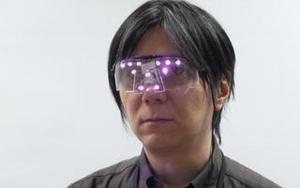Privacy protectionThwarting facial-recognition, photo-tagging software
Information about when and where photographed subjects were when their pictures were taken is readily disclosed through photos taken, and the information is disclosed and distributed without their permission. The problem has become even worse due to the popularization of portable terminals with built-in cameras and developments in SNS and image search technologies. Japanese researchers offer a solution: goggles or glasses which, when equipped with near-infrared LED emitter. :

Japanese-developed visor renders electronic photo impossible // Source: nii.ac.jp
Japan’s National Institute of Informatics (NII) associate professor, Isao Echizen has developed new technology for protecting photographed subjects from the invasion of privacy caused by photographs taken in secret and unintentional capture in camera images jointly with Prof. Seiichi Gohshi of Kogakuin University. Information about when and where photographed subjects were when their pictures were taken is readily disclosed through photos taken, and the information is disclosed and distributed without their permission. The problem has become even worse due to the popularization of portable terminals with built-in cameras and developments in SNS and image search technologies.
The need to protect the privacy of individuals is this even more pressing now.
An NII release reports that the new technology disable facial recognition of photographed subjects when photos are taken. It achieves this by the photographed person wearing a privacy visor that incorporates a near-infrared light source that affects only the camera and not people’s vision. In addition to being able to protect photographed subjects from the invasion of privacy resulting from the facial recognition functionality of SNSs, this new technology is expected to enjoy extensive application in preventing the invasion of privacy of photographed subjects due to widespread use of augmented reality applications.
Techniques for protecting people’s privacy by physically shielding their faces or techniques for causing detection of people’s faces to fail by coloring their face or altering their hairstyle have been proposed as measures for preventing unintentional capture in camera images.
The new technique is different in that it uses the differences in human senses and the spectral sensitivity characteristics of imaging devices on cameras. The visible range of humans, according to the International Commission on Illumination, which recommends standard specifications relating to light, is 380 to 780 nm. Image sensors, such as CCD or CMOS used in digital cameras, have a sensitivity over a wide area of roughly 200 to 1100 nm.
The proposed technique prevents recognition of people’s faces by adding “noise” to photographed facial images by irradiating near-infrared rays. Note that these rays react with only to the imaging device on the camera and do not affect people’s vision.
Near-infrared ray irradiation from the face — the “noise” light source — is achieved by incorporating a near-infrared light source into spectacles or goggles regularly worn by people. This was the reason for the team developing a wearable device — a privacy visor — equipped with a near-infrared LED in commercially available goggles.
When the near-infrared LED in the privacy visor is not lit, people’s faces can be seen as if they were wearing regular goggles or glasses, and so facial detection is not affected, allowing for normal person-to-person communication.
When the near-infrared LED in the privacy visor is lit, near-infrared rays are recorded as noise in the camera’s imaging device. Because this noise appended to the facial image causes a considerable change in the amount of features which are referenced during the facial detection process, facial detection is misjudged and recognition of people’s faces is prevented.
